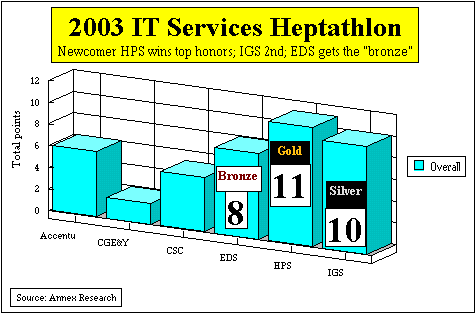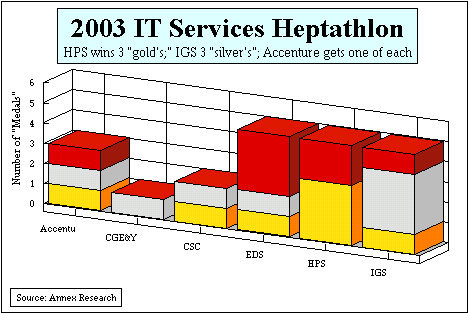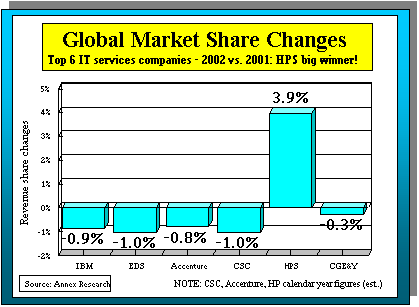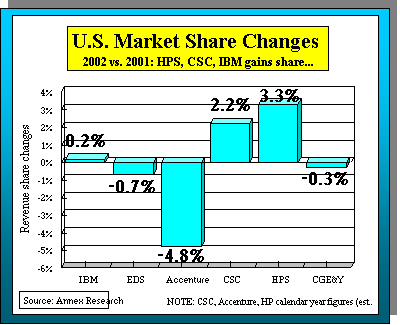

Annex Research| Annex Bulletins|
Index 2003 | Search| Feedback| Clips| Activism| Quotes|
![]()
The copyright-protected information contained in the ANNEX
BULLETINS is a component of the Comprehensive Market Service (CMS). It is
intended for the exclusive use by those who have contracted for the entire
CMS service.
An Open Client Edition
![]()
IT SERVICES
Updated 6/04/03, 10:45 a.m. PDT (updates profitability stats/charts)
Annex Research Heptathlon 2003: Global
IT Services Leaders’ Results
A Cinderella Story
Newcomer (HPS) Tops All “Top 6” Contenders
for Overall “Gold” Medal
PHOENIX,
May 23 - The big
winner of the 2003 Annex Research Global IT Services Heptathlon is a
newcomer to the major leagues of IT services - Hewlett-Packard Services
(HPS). HPS won three “gold” and two “bronze” medals, earning
11 points and the overall
“gold,” ahead of IBM Global Services (IGS), which ended up with 10 points and the overall “silver.”
EDS won the "bronze” with eight points.
HPS’
overall “gold” medal performance is like a trip from “Obscurity
to Stardom.” It’s a
Cinderella story. It’s as
if an expansion team were to win the World Series in its first season. And to do it with ease… in, say, five games. Just to
recap quickly for our new readers the IT Services Heptathlon scoring…
the overall medal standings are determined by awarding three points for a
“gold,” two points for a “silver,” and one point for a
“bronze” in each of the seven competition categories. And
now, here’s a “play-by-play” narration of the 2003 Cinderella
story…
Revenue
Growth (2 Medals) HPS swept both revenue “gold” medals
in the 2003 Heptathlon. It
won the first one for the year-over-year growth (70% for 2002/2001). It earned the second for the long-term growth (23% for
1997-2002). No one else was even close.
The “silver” medal in the first revenue category went to IGS
for a 4% 2002/2001 increase. EDS
won “bronze” with a 2% rise during the same period.
The “silver” for long-term growth
went to CSC (18% per year during 1992-2002).
Accenture earned the “bronze” with a 15% compound annual growth
in the last decade. As in our previous Heptathlons, all
revenue figures used in this year’s competition were either reported
numbers for companies whose fiscal year-end is Dec 31, or were our
estimates of other competitors’ calendar year 2002 results. The main reason for such an impressive
revenue “gold” medal sweep by the newcomer, of course, was HP’s
acquisition of Compaq, completed just over a year ago.
Since Compaq had a bustling services business, thanks mostly to its
1998 takeover of Digital Equipment Corp. (DEC), HPS grew by leaps and
bounds practically overnight (see “From
Obscurity to Stardom”, May 13). It was a classic example of “growth by
acquisitions,” or by a single investment banking “megadeal” in this
case. Of course, some other competitors have also boosted their
revenue growth by acquisitions.
IBM,
for example, bought PriceWaterhouseCoopers Consulting (PwCC) last year
(see “IGS:
Investing in Growth,” Apr 30).
But PwCC’s impact on IGS 2002 growth was far less dramatic than
in HPS’ case, because only the last quarter’s figures were included in
the 2002 results. CSC is another competitor that has been
growing by leaps and bounds during most of the 1990s by acquisitions. And even now, well into the first decade of the 21st
century, the company is continuing to do so, such as with its latest
purchase of DynCorp, a defense contractor (see "Less
Than Meets the Eye", May 16).
Cap
Gemini also leaped ahead by a single big acquisition when it bought Ernst
& Young Consulting in 2000 (see “Solid
Growth After the Merger,” Mar 2001). And even EDS did it back in 1996, after
it purchased A.T. Kearney (see “EDS Stock Drops Like a Rock,” Annex
Bulletin 96-51, Oct 23, 1996). It
was the deal that may have precipitated the spate of subsequent consulting
firms mergers and acquisitions. Accenture is the only company among the
Top 6 whose growth has been mostly organic (internal).
In fact, Accenture (formerly known as Andersen Consulting) had to
overcome the reverse problem - breaking away from Arthur Andersen. When it finally did that in mid-2000, after a bitterly
contested arbitration process, Andersen Consulting went public in July
2001 under the name Accenture. Given
what happened with Arthur Andersen in the aftermath of the Enron scandal,
the timing of Accenture’s break-away could have been more fortuitous.
So as you
can see, slowing growth is not a new trend.
This what we said about it a year ago:


 A
slowdown in the combined Top 6 IT services companies’ growth rates
continued in 2002, too. The
average growth was only 6%, down from 11% the year before.
The 10-year compound annual revenue growth has also slowed down -
from 17% per year in 1991-2001, to 13% annually in 1992-2002.
The 20%+ growth rates of the 1990s now seem like a
distant dream.
A
slowdown in the combined Top 6 IT services companies’ growth rates
continued in 2002, too. The
average growth was only 6%, down from 11% the year before.
The 10-year compound annual revenue growth has also slowed down -
from 17% per year in 1991-2001, to 13% annually in 1992-2002.
The 20%+ growth rates of the 1990s now seem like a
distant dream.
Yes,
it is easy to say that the field is getting more saturated as the
traditional (large) customers are cutting back on capital spending.
But we’ve been saying that would happen at least since 1996 (see “Louis
XIX of Armonk,” Aug. 1996).
Strike “saying.” Make it shouting!
But
it is human nature to sit by a familiar cash cow and keep milking her for
as long as the udder keeps dripping, instead of going out and seeking some
new ones. Scant few of the
top IT services vendors have heeded our advice to expand their range and
reach deeper down in the marketplace, to small and medium size
businesses.
(see
IT
Services Heptathlon, May 2002)
Well, such a move is finally underway (see “IBM to Focus on Small and Medium Company Market,” Jan 2003), though not yet in a big way, nor in the IT services arena. But the longer the flat or declining revenue curves continue, the more pressures will be applied to the top executives to find new avenues for growth.
Market Share Gains (1 Medal)
Given its strong revenue growth, perhaps
it should not be surprising that HPS also won the market share gain
“gold” medal for 2002. The
“silver” medal for overall global market share performance went to
Accenture, while the “bronze” went to IGS.

On a global scale, HPS gained almost four points from its top competitors (+3.9%), all of whom lost share last year.

But that was not necessarily the case in all world regions. In Europe, for example, it was Accenture that posted the biggest market share gains (+5.4%), accompanied by the biggest market share losses (-5.5%) suffered by CSC (see the charts for details).

Similarly, in the U.S., the world’s biggest
market, HPS, CSC and IBM gained share at the expense of others.
Profitability
Accenture again won easily the gross margin “gold,” followed by CGEY and HPS which claimed the “silver” and the “bronze” respectively.

The net margin “gold” went to IGS this year, followed by EDS, which won the “silver” in a "photo finish" over HPS - the "bronze" winner.
Frugality (1 Medal)
One of the more beleaguered competitors in 2002 - EDS - continued its unfettered grip on the “gold” for frugality (the lowest operating expenses). At 8.8% of revenues, EDS’ operating expenses are by far lower than those of the “silver” medal winner IGS (12.7%) and the third place finisher HPS (13.2%).
Which makes it all the more ironic that Wall Street is now again expecting cost cuts from the new EDS management team, instead of focusing on the top line growth and gross margin improvements. The latter two are areas in which EDS is lagging behind its top competitors (see the Profitability chart).
Sales Productivity (1 Medal)
CSC won again the “gold” in the sales productivity category with revenue per capita of about $219,000. The “silver” and the “bronze” went to IGS and EDS respectively.

Summary
As
we also noted last year, “the universe is unfolding as it should…”
(see “Industry
Stratification,” Mar 1990).
Customers and their IT services providers are finally beginning to
partner in earnest when making the outsourcing and other IT services
deals. Last
year showed several new examples of that.
HPS,
the 2003 Cinderella, was a clear Heptathlon winner this year, mostly
because of the Compaq acquisition.
But the benefits of that will quickly wane unless the company also
shows internal growth.
The three megadeals HPS closed announced in March will help.
But
IGS has also been on a tear in closing new business.
Sooner or later, EDS will also wake up from its slumber and start
to grow again, as will CGE&Y, a company that ended up in the cellar of
this year’s Heptathlon.
CSC
has already announced it plans to be a $14 billion to $15 billion company
in its current fiscal year.
So the 2003 race card is full and contests promise to be quite
exciting.
Who
will be the winner this year?
Find out when you join us in about one year’s time.
Until then…
Happy bargain hunting!
Bob
Djurdjevic
P.S. Happy Memorial Day to our U.S. clients and readers!
![]()
For additional Annex Research reports, check out...
2003 (IBM): “Save, Spend and Split” (May 8), “Shrunk by the Marketplace” (Apr 17), “Turnaround Continues...” (Apr 15), “Start of a Real Turnaround?” (Jan 17).
Last
three Heptathlons:
Annex
Research IT Services Heptathlon 2002 (May 21, 2002); IT
Services Heptathlon 2000 (May 11, 2001); 1999
IT Services Heptathlon (Apr 17, 2000)
![]()
